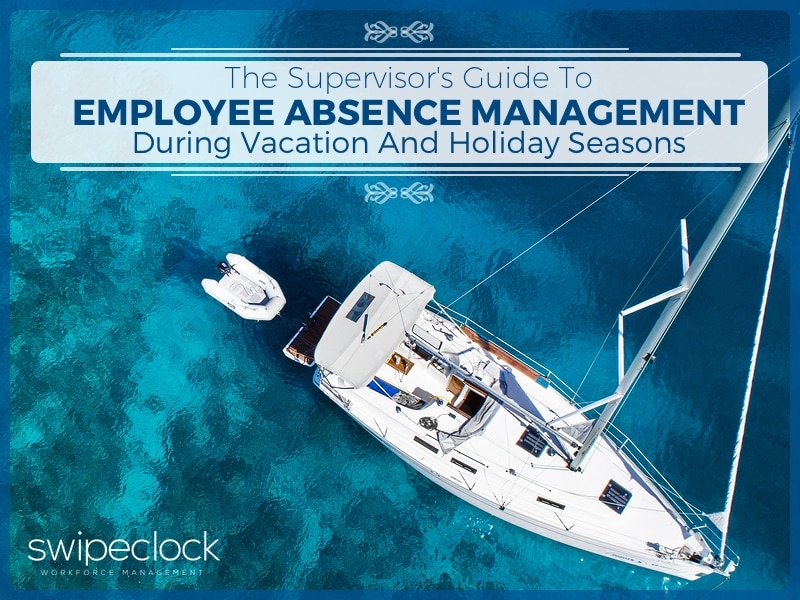The Supervisor’s Guide to Employee Absence Management During Vacation and Holiday Seasons

Summer vacations and holiday celebrations can take a toll on workplace productivity. Employee downtime doesn’t have to mean losing business momentum. Employee absence management can keep your business running smooth.
Around this time each year, management starts to worry about the impact of vacations. Employees are starting to talk about taking time off and the schedule is in peril. Supervisors are on alert, managers are on edge, and owners are showing concern.
Don’t Panic. It’s all going to be OK.
Employee absence management strategy can help you reduce the impact. A few best practices and capable workforce management software (WFM) are all you need.
Strategy 1: Get The Balance Right
There’s a tug of war between management and employees during vacation season. Employees need some time off and want to take advantage of school schedules and good weather. Managers see competitive opportunity in the heart of the sowing season.
Good managers will see this challenge as an opportunity to plan ahead and find a good balance. Employees need breaks to remain productive. They also need to be able to enjoy recreation time with family and friends, else “what are they working for?”
The Society for Human Resource Management (SHRM) conducted a vacation survey. They asked managers to report on employee time off and productivity.
The survey revealed that employees who use vacation time are more productive. Employees who take scheduled time off also enjoy higher morale. Companies that encourage planned time off report higher performance and improved employee wellness.
Companies with strategic absence management also report higher employee retention.
So, while it may be tempting to keep your employees knee deep in elbow grease, it pays to give them a break. Finding the right balance is key, but don’t be afraid to give employees scheduled time off; they need it, and so do you.
Strategy 2: Start The Conversation Early
Effective employee absence management starts with communication. There are three good times to start talking to your employees about planning time off:
- At their hire date
- During quarterly reviews
- Before vacation and holiday seasons arrive
Paid time off (PTO), vacation time, and holidays should be a matter of company policy. PTO policy should be part of your employee onboarding program. Include PTO policy in your employee handbook, and discuss key points in orientation.
Quarterly reviews are a good time to discuss planned PTO. Your review process should include employee absence management discussions with your employees. Use quarterly reviews to chart future plans and confirm planned time off.
Employee absence management demands vigilance from managers, especially during seasonal high tide. Summer months, winter holidays, and three-day weekends are all events to watch for. Survey your employees well before holidays to get a sense of how they will impact your schedule.
Start the conversation early and keep it going through the year. Maintain an open dialogue with your employees as part of an absence management plan. Create a culture of planning and train employees to schedule time off in advance.
Strategy 3: Schedule in Advance
Companies that schedule more than two weeks in advance have higher employee morale. The further out ahead you can post a schedule, the happier your employees will be.
Managers procrastinate scheduling because they think there will be new information to consider. A study conducted by Lambert and Henly found the opposite is true. They found that for almost two-thirds of their schedules, over 80% remained the same from week to week. The fact of the matter is this; you can schedule well in advance and expect very little change.
Reduce employee uncertainty by creating shift schedules as far in advance as possible. Employee absence management starts with a good plan and your WFM software.
Workforce management scheduling software can help create schedules based on pre-built templates. Templates make it easy to drag-and-drop new schedules and post them as early as possible. WFM software helps lower the work needed to make schedules and helps you get this done quicker.
Completed schedules allow employees to plan ahead. With open communication, your schedule will become an effective vacation planning tool. Employees can make adjustments to schedules further ahead. Advanced planning will reduce the impact of change.
Strategy 4: Allow Self-Service Shift Swapping
In the event that last-minute changes occur, and they always do, it’s good to have a solution in place. Employee self-service is a workforce management tool that can help with unplanned changes.
Employee self-service allows your employees to submit schedule changes and swap requests. These changes occur in the WFM software.
Changes made within the WFM software are subject to overtime alerts and gap warnings. WFM software reduces errors and assures that you maintain qualified coverage.
With employee self-service, your employee absence management strategy expands to include employee planning. This will lighten your management burden and build stronger scheduling routines.
Employee self-service allows your employees to volunteer for open shifts. This makes a quick turnaround of emergency staffing problems a matter of routine. Employees will be able to plan for far-reaching PTO and can react to short-term shortages.
Managers are free from worry and can focus on approvals. Employees enjoy the empowerment of managing their own schedule.
Strategy 5: Enforce Best Practices
Employee absence management is a business strategy. As such, you must work to enforce best practices and build a culture of compliance.
When managers and employees share absence management goals, the company benefits. Absence management should be a matter of company policy. It should be an enforced process, and part of the culture of the business.
Workforce management software such as WorkforceHUB™ can help enforce absence policy.
WorkforceHUB includes advanced scheduling features. It also provides an employee self-service portal that allows for virtual trade boards.
WorkforceHUB is an excellent solution for your employee absence management strategy.
Simplify HR management today.
Simplify HR management today.
Navigating the Complexities of Healthcare Recruitment
The healthcare sector is renowned for its rewarding nature, offering professionals the chance to significantly impact individuals’ lives by aiding in their recovery from various ailments and conditions. However, for those tasked with recruitment within this sector, the challenges are plentiful. Delve into our in-depth guide for an array of strategies to elevate your healthcare…
Read MoreHow Improving Candidate Engagement Influences the Hiring Process
Applicants invest considerable time, effort, and thought into their job applications. Regrettably, it’s all too common for employers to delay responses, with some failing to provide any follow-up whatsoever. Such practices can have a negative effect on the candidate experience, influencing your organization’s hiring efficiency and reputation. Ensuring a positive experience for candidates is crucial…
Read More




